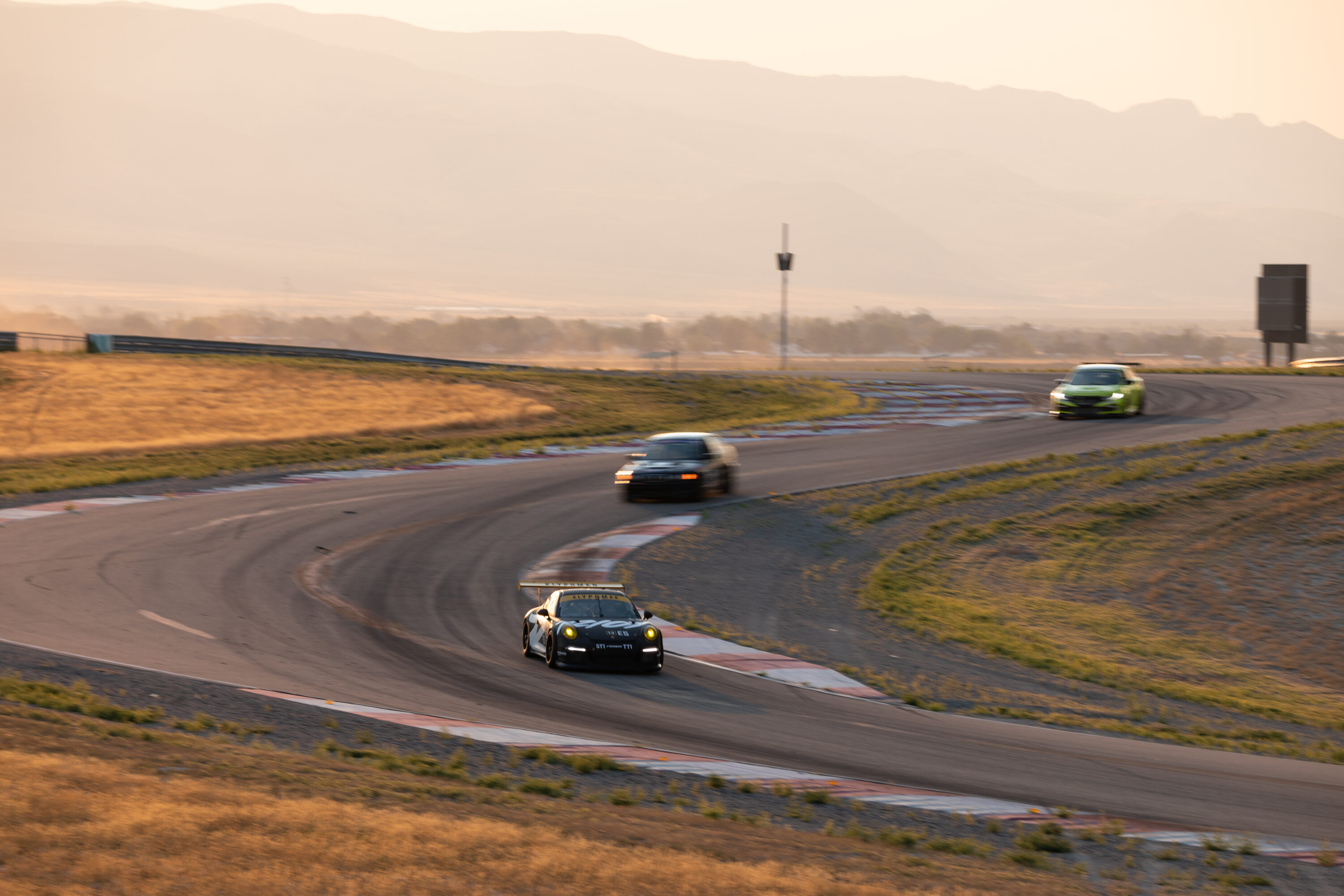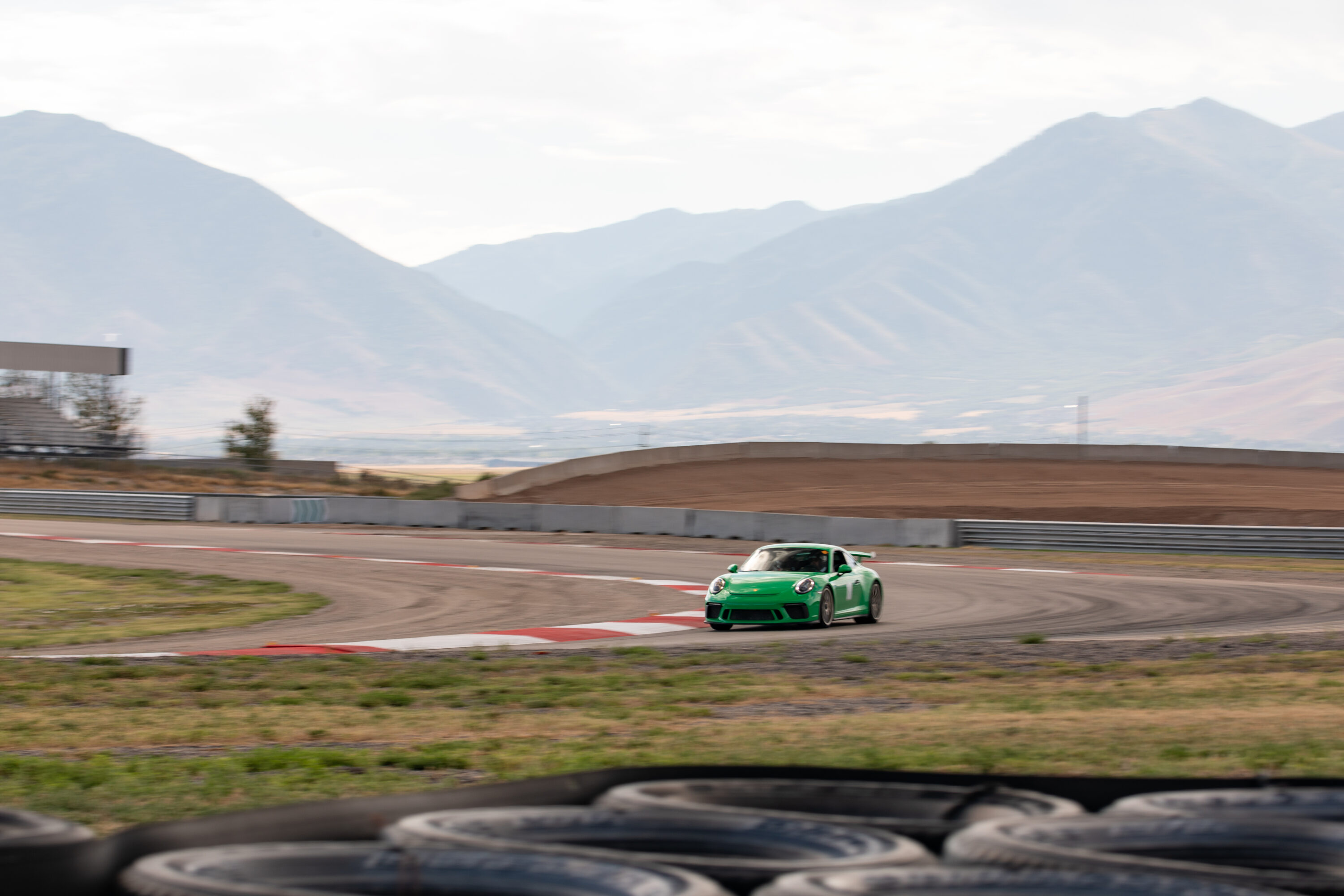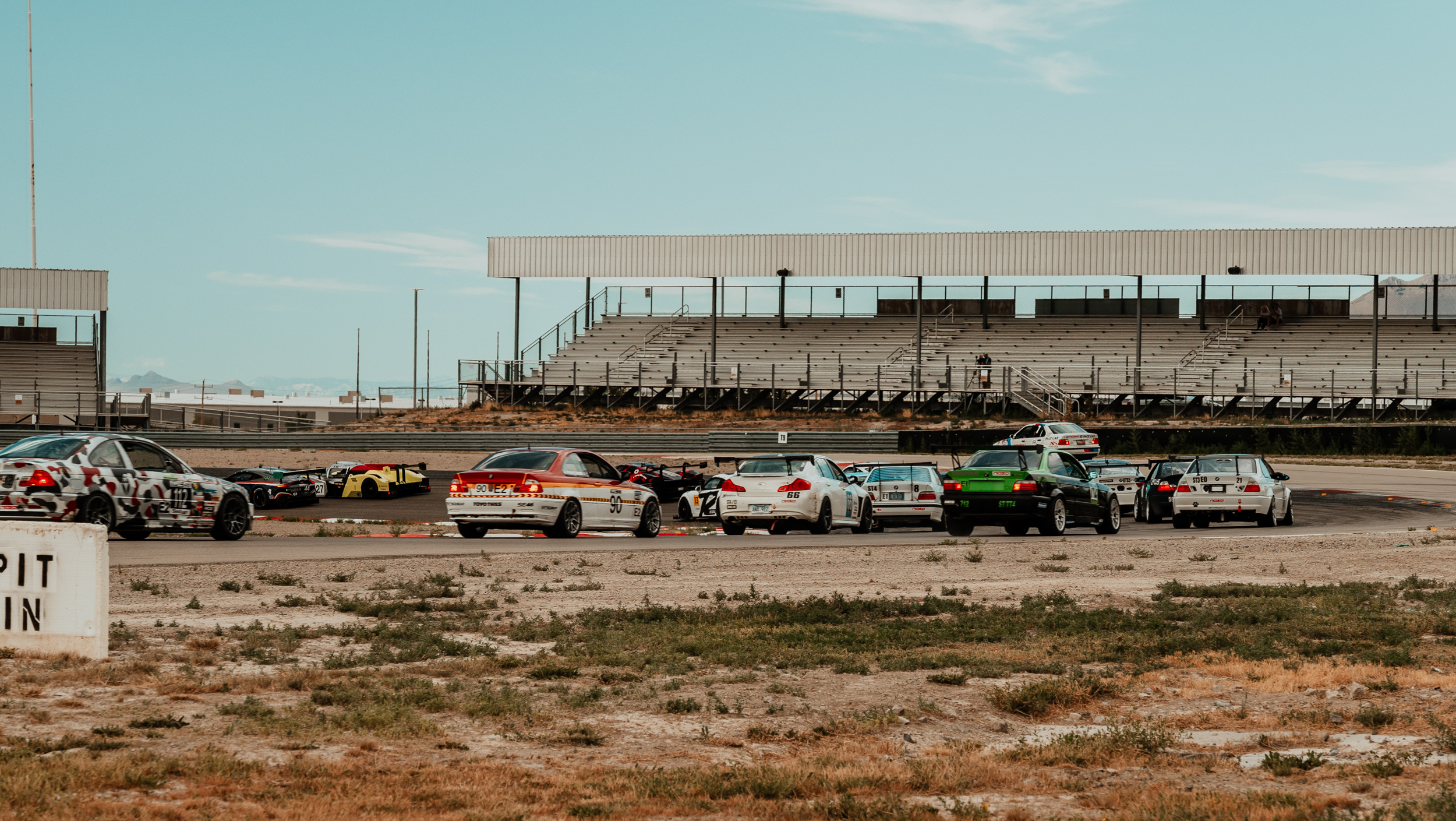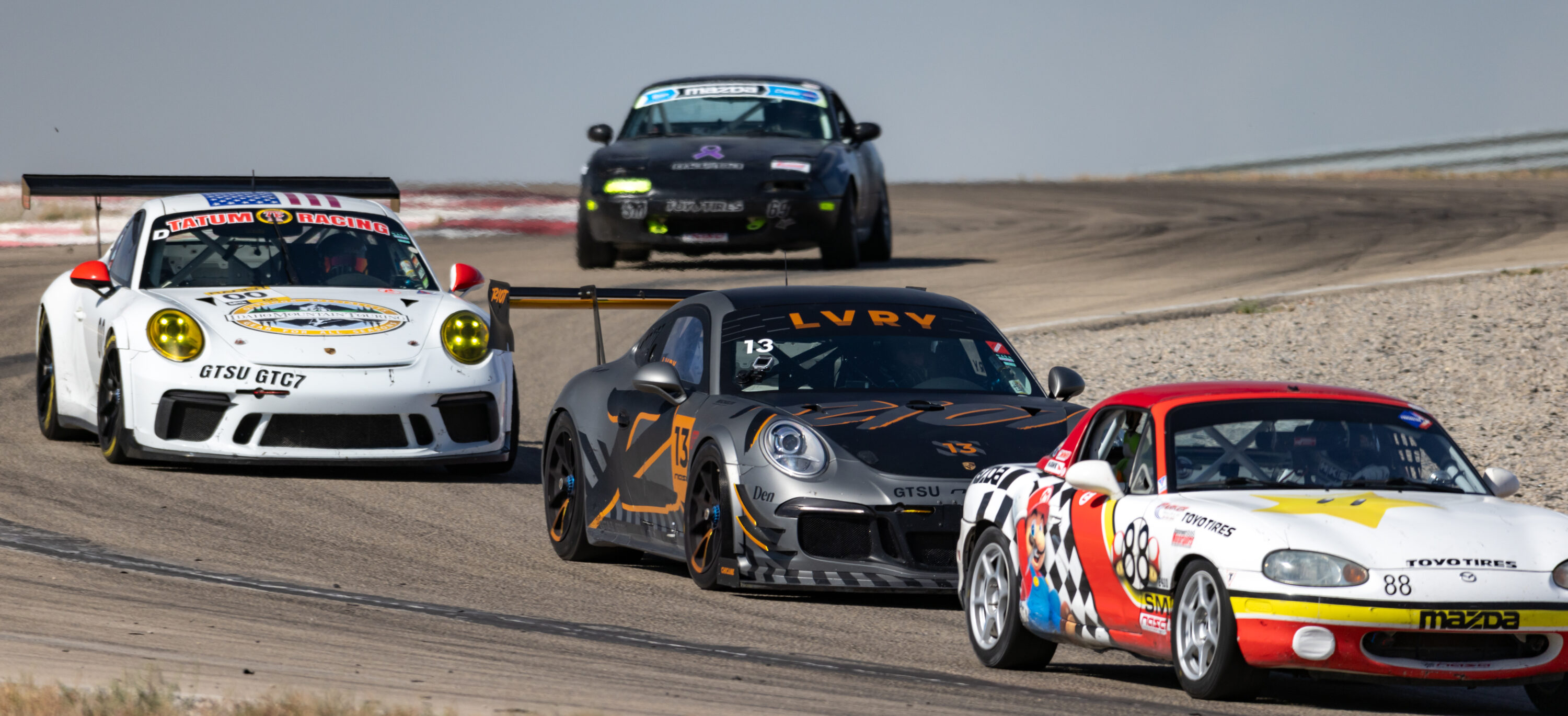Photo Credit: Dewfus Art
One of the quintessential symbols of racing are the (typically) red-and-white painted kerbs (or curbs) that line various sections of a track.
Watching Formula 1 and other series, one would think that they’re always useful and can be taken at all sorts of angles… then we try it for ourselves and our experiences vary.
Sometimes, it feels fantastic — the car rolls smoothly over the inside kerb, allowing us to add throttle and push pace with a nicely-settled chassis.
Other times… it feels like we’re going to blow a shock or we get jounced to the side, having to counter-steer or even take a significantly-altered line to gather the car back up.
Let’s look into some of the nuances of kerbs and think through what happens with the car.
Three Basic Types of Kerb at UMC
For this article I’ll reference my home track, Utah Motorsports Campus, which uses three different types of kerbing — sometimes alone and sometimes in combination with each other: Flat, Humped, and Stepped.
Flat
Flat kerbing runs flush with the main racing surface. It’s painted and is completely smooth. You can drive over this without even feeling the difference in dry weather. Two corners that feature this type of kerbing are the last set of kerbs on track-right at the exit of West Turn 5 (Blackrock Hairpin) and the track-right exit of West 10.
On West Ten, this area is nick-named the “triangle of death”, because if you track-out too early and hit the dirt before this small set of kerbing, you very likely will bend a wheel and/or break a suspension component. This happens due to cars “digging out” the dirt as they hang a tire a little bit (or a lotta bit) over the edge of the track, kicking the dirt up and exposing the naked front-edge of concrete. (Been there, not a good feeling!)
The name of the game is to use this as if it is just an extension of the asphalt whenever possible, as it makes the track wider and allows us to carry a shallower steering angle and more speed (at least in the corners I’ve mentioned). No adjustments necessary if you’re anywhere close to the right line.
Humped
This stuff is smooth, but rises significantly above the racing surface. It’s typically found along the apex areas of the track and can be used if you strike it just right. It can also “throw” your car off-kilter if you strike it incorrectly.
“Just right” often means:
- Early, where the angle of the kerb’s rise is shallowest
- When you have a good amount of steering angle dialed-in
- Coasting works OK, while on-throttle works even better
- When you’re low-speed and need to cut the corner to shorten the track
The key here is to get the inside tires to be “light”. We do this by turning-in earlier than if we were to apex outside of the kerbing and still dialing-in quite a bit of steering angle. This transfers load to the outside tires, allowing the inside tires and suspension to absorb the impact more smoothly and not upset our car (very much, but ideally not at all).
In my opinion, this is the kerbing that will make the biggest positive impact in our lap pace if used correctly, but is harder to learn to use than the other two types.
Stepped
This stuff is typically found on corner entry, on the outside as we brake and turn-in. It’s also found on corner-exit. Finally, it is found further beyond humped kerbing.
The terms “rumbles” or “gators” are often used for this type of kerbing, as it makes a recognizable vibrating sound (and shakes the car quite a bit) when driven over… kind of like the sound you hear if you run a piece of paper over the blades of a fan.
I call these kerbs “stepped”, but they’re really like a series of ramps. The tire rolls up the ramp, then drops to the bottom of the next and repeats the process. These kerbs are safe to drive on at high speed and are typically intended to be a safety margin that is not always optimal to drive on, but sometimes can be used to widen the track.
Stepped kerbing is useful, depending on a few things:
- How aggressive the ramp angles and drops are
- The speed carried in the corner
- The type of corner
- The car
In general, my goal is to avoid touching this kerbing under braking, clip it at turn-in or track-out, and fully drive on it only when I make an error.
Using the Kerbs on UMC’s “Attitudes”

One set of corners that kerb-usage is crucial in are “The Attitudes” — the set of left, right, left corners that go downhill on the east half of the track.
The car’s suspension and tire sidewall height have to be compliant-enough for these kerbs to be useful, however. If the suspension is too stiff and/or the tire sidewalls are too short, it’s unlikely that you’ll find these kerbs useful — you’ll likely find them rather damaging.
Assuming the car “likes” kerbs, though, here’s the approach:
- Stay off the kerbs to track-right as you brake and begin turn-in to the First Attitude
- Clip or drive over the humped kerbing at the apex of the First Attitude. Driving over this kerb can be harsh, so make sure you dial-in a lot of steering and be off the brakes before hitting this kerb
- Plant the car’s center line over the edge of the massive mound of humped and stepped kerbing of the Second Attitude. The key here is to carry enough speed that you have to turn the wheel to get back track-right for the final corner, Bad Attitude. By having a lot of steering angle and being able to be committed to throttle, the car should rotate nicely over this set of kerbing, just clipping the stepped kerbs on the far right, but having the left tires firmly planted on the asphalt.
- If done correctly, you should be able to have a fairly shallow steering angle to go left through Bad Attitude, just clipping the humped kerb and get practically thrown at the stepped kerbs of track-out to the right. You can clip these kerbs or plant a full tire on them if need-be
If you don’t quite get it right, there’s a lot of margin for error (but it might be a bumpy ride! The car is going to “like” these kerbs best if you can have steering angle and momentum as you strike the kerbs. You’ll know you nailed it when it feels smooth and you don’t strike any of the stepped kerbing in the Second Attitude and the sequence feels extraordinarily smooth — as if you didn’t strike any kerbs at all! It’s a race and fantastic feeling!
It’s a fine line, but I’ve found that the biggest mistake I used to make is to drive straight over the kerbs, thinking that having the suspension neutral and equally loaded would help. Wrong! I needed to have the tires striking the kerb the be “light” so as to be more compliant. It was a major “aha” (and kind of “oh… duh”) moment for me.






